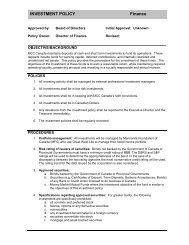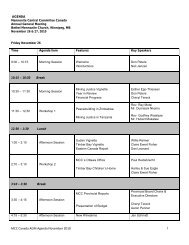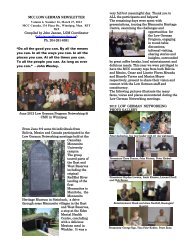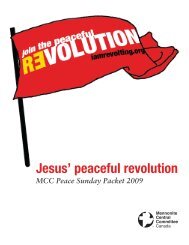Walking together: Healing and hope for Colombian refugees
Walking together: Healing and hope for Colombian refugees
Walking together: Healing and hope for Colombian refugees
Create successful ePaper yourself
Turn your PDF publications into a flip-book with our unique Google optimized e-Paper software.
w a l k i n g<br />
t o g e t h e r<br />
49<br />
Gestures: A human being’s height is always demonstrated with the palm of the h<strong>and</strong> held out facing<br />
sideways while the height of animals is demonstrated with the palm of the h<strong>and</strong> facing down. Most<br />
<strong>Colombian</strong>s are shocked when they see a Canadian indicate the height of a person with a downward<br />
facing palm.<br />
Yawning may indicate hunger as well as tiredness.<br />
Last Names: <strong>Colombian</strong>s have two last names, the first one inherited from their father <strong>and</strong> the second<br />
from their mother. <strong>Colombian</strong> parents pass on the first of their own two last names to their children. For<br />
example, if Pablo Ortiz Padilla <strong>and</strong> Sara Herrera Dominguez have a child named Ana, Ana’s full name will<br />
be Ana Ortiz Herrera. Both parents’ first last names are taken into account when referring to the family<br />
group, thus Pablo, Sara <strong>and</strong> Ana will be known as the “Ortiz Herrera family.” A common mistake <strong>for</strong><br />
Canadians is to assume that all the members of a <strong>Colombian</strong> family will share a common last name, <strong>and</strong><br />
that this last name will be the father’s second last name (In the case of our example, many Canadians<br />
would mistakenly assume that Pablo, Sara <strong>and</strong> Ana are the ‘Padilla family’ - this will sound very odd to<br />
the <strong>Colombian</strong> family.) For most <strong>Colombian</strong>s the idea of a woman changing her name at marriage to<br />
her husb<strong>and</strong>’s last name seems both archaic <strong>and</strong> sexist. Occasionally a mother will pass both of her<br />
last names on to her children, especially in situations where the father is not present or does not take<br />
responsibility <strong>for</strong> the child.<br />
Religious Composition: Most <strong>Colombian</strong>s consider themselves to be religious, with some 90%<br />
identifying as Catholic. Most of the remaining 10% belong to Protestant denominations, especially<br />
common are the Evangelical, Pentecostal <strong>and</strong> Neo-Pentecostal movements, however there is also a<br />
small but significant presence of historical churches such as the Lutheran, Mennonite, Presbyterian,<br />
Baptist <strong>and</strong> Methodist. Along with indigenous religions, a minor percentage of the population identify<br />
as Mormon, Jehovah’s Witness, Muslim or Jewish, while others identify as Buddhist or atheist. The<br />
Constitution of 1991 recognized freedom of worship <strong>and</strong> no longer identified the Catholic Church the<br />
official state church. Prior to this, in the 40s, 50s <strong>and</strong> 60s, during a time known as “The Violence,” there<br />
were periods of fierce religious persecution <strong>and</strong> violence, primarily directed from Catholics towards non-<br />
Catholics, <strong>and</strong> only recently have ecumenical movements begun.<br />
Importance of Class: <strong>Colombian</strong> society is heavily stratified, based on an economic class system.<br />
One of the clearest ways in which class divisions are marked is that of the “strata” markings of each<br />
neighbourhood. Throughout <strong>Colombian</strong> cities, each neighbourhood is assigned a number, from one<br />
to six, with one being the lowest stratum, <strong>and</strong> there<strong>for</strong>e the poorest neighbourhoods <strong>and</strong> six being the<br />
highest stratum <strong>and</strong> most affluent neighbourhoods. The cost of rent <strong>and</strong> public services such as water,<br />
electricity, natural gas, telephone lines <strong>and</strong> internet are priced respective to the strata, with lower costs<br />
in lower strata <strong>and</strong> higher costs in upper strata neighbourhoods. In some cities neighbourhoods from<br />
different strata are intermixed, while in other cities there is great separation between neighbourhoods of<br />
high <strong>and</strong> low strata. In many cases <strong>Colombian</strong>s from the highest strata may have never set foot in strata<br />
one or two neighbourhoods. The decision to geographically stratify cities was a government decision,<br />
made in order to organize the payment of taxes <strong>and</strong> services.











